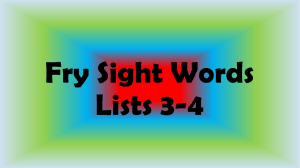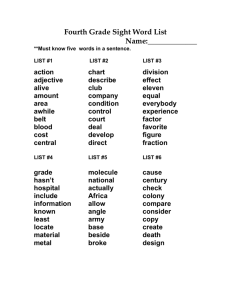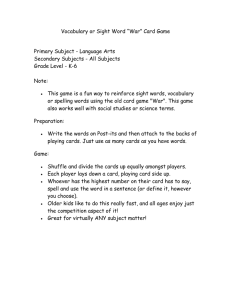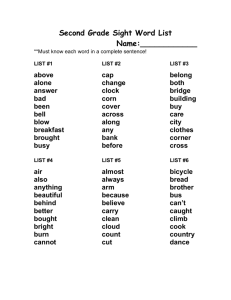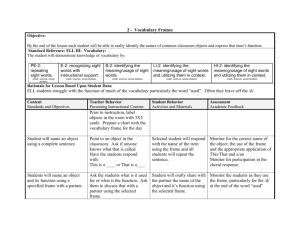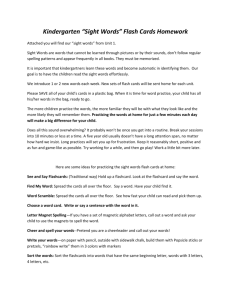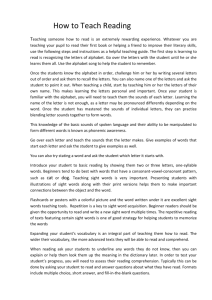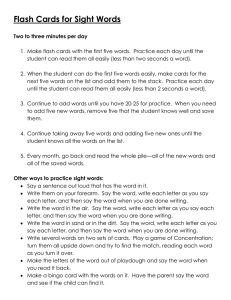Professional Literacy Portfolio - Lisa Quraish
advertisement
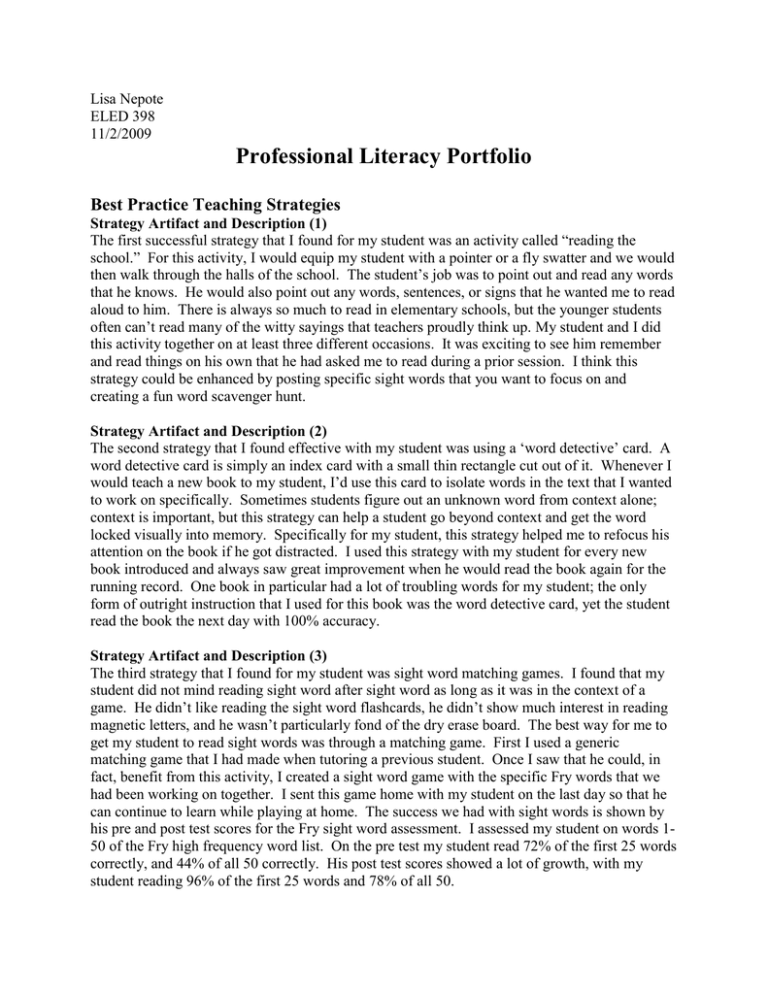
Lisa Nepote ELED 398 11/2/2009 Professional Literacy Portfolio Best Practice Teaching Strategies Strategy Artifact and Description (1) The first successful strategy that I found for my student was an activity called “reading the school.” For this activity, I would equip my student with a pointer or a fly swatter and we would then walk through the halls of the school. The student’s job was to point out and read any words that he knows. He would also point out any words, sentences, or signs that he wanted me to read aloud to him. There is always so much to read in elementary schools, but the younger students often can’t read many of the witty sayings that teachers proudly think up. My student and I did this activity together on at least three different occasions. It was exciting to see him remember and read things on his own that he had asked me to read during a prior session. I think this strategy could be enhanced by posting specific sight words that you want to focus on and creating a fun word scavenger hunt. Strategy Artifact and Description (2) The second strategy that I found effective with my student was using a ‘word detective’ card. A word detective card is simply an index card with a small thin rectangle cut out of it. Whenever I would teach a new book to my student, I’d use this card to isolate words in the text that I wanted to work on specifically. Sometimes students figure out an unknown word from context alone; context is important, but this strategy can help a student go beyond context and get the word locked visually into memory. Specifically for my student, this strategy helped me to refocus his attention on the book if he got distracted. I used this strategy with my student for every new book introduced and always saw great improvement when he would read the book again for the running record. One book in particular had a lot of troubling words for my student; the only form of outright instruction that I used for this book was the word detective card, yet the student read the book the next day with 100% accuracy. Strategy Artifact and Description (3) The third strategy that I found for my student was sight word matching games. I found that my student did not mind reading sight word after sight word as long as it was in the context of a game. He didn’t like reading the sight word flashcards, he didn’t show much interest in reading magnetic letters, and he wasn’t particularly fond of the dry erase board. The best way for me to get my student to read sight words was through a matching game. First I used a generic matching game that I had made when tutoring a previous student. Once I saw that he could, in fact, benefit from this activity, I created a sight word game with the specific Fry words that we had been working on together. I sent this game home with my student on the last day so that he can continue to learn while playing at home. The success we had with sight words is shown by his pre and post test scores for the Fry sight word assessment. I assessed my student on words 150 of the Fry high frequency word list. On the pre test my student read 72% of the first 25 words correctly, and 44% of all 50 correctly. His post test scores showed a lot of growth, with my student reading 96% of the first 25 words and 78% of all 50. Strategy Artifact and Description (4) The fourth strategy I found to be effective with my student was the writing sand. During our sessions I tried to introduce three new sight words a day. While the matching games were effective in helping my student to visually recognize the words we were working on, I wanted to find an activity that would help him learn how to spell/write them, as well. He didn’t show much interest in the “look, say, cover, write, check” folder, and the dry erase board lost its novelty after a couple of uses. My student never tired of the use of sand as a writing strategy, though. We would go through word after word and he would eagerly “write” in the sand with his finger. He learned to successfully write over nine sight words using this method. Strategy Artifact and Description (5) One final strategy that I found to be successful with my student was the “Words I am Learning to Read/Write” folder. As I said previously, I placed a heavy focus on introducing new sight words to my student. We used a variety of strategies to work on reading and writing, but the matching game and writing sand were the most effective. The “Words I am Learning to Read/Write” folder served as excellent motivation for Isaac. He would write the new words that he had learned to write/read with 100% accuracy in the corresponding box himself. The folder allowed him to really see his progress, and it motivated him to want to learn more so that he could add words to more of the boxes. Assessment Tools Assessment Artifact and Description (1) Hearing and Recording Sounds in Words (Dictation task) Dictation tasks are often used in foreign language courses, but prior to this I was unfamiliar with using them in this context. I think a strong point of this assessment is that the administrator is more concerned with the appropriate sounds in words as opposed to standard spelling. My student omitted some sounds, such as the ‘a’ in ‘car’ and the ‘-ing’ at the end of ‘going.’ What I found even more interesting was the incorrect sounds, such as a ‘g’ at the start of ‘come,’ and an ‘a’ in the word ‘down.’ This assessment gives good insight into the actual thinking process that the student goes through when trying to identify the appropriate sounds in both reading and writing. Having this knowledge helped me to find more effective ways of correcting his writing errors during the writing portion of our lessons. Assessment Artifact and Description (2) Sight Words (Fry List) Pre and Post test For me, the sight word pre and post tests were probably the most beneficial in helping me to really gauge my student’s progress throughout our short time together. I only gave him two of the four lists (50 words), because he showed a lot of frustration as we approached the third list. For the pre-test, my student read words 1-25 with 72% accuracy and words 26-50 with 44% accuracy. I took note of all of the words he missed, and we focused on three of these words a day for the remainder of our sessions. I am pleased to say that the post-test indicates that all of our sight word practice really worked. My student jumped from 72-96% accuracy on words 125, ad from 44-78% o words 26-50. I am extremely impressed, and feel satisfied that I have at least helped him in this crucial area. Assessment Artifact and Description (3) Writing Vocabulary I had never administered an assessment quite like this before and was pleasantly surprised by the knowledge I gained from it. This assessment is administered after the sight word assessment. The gap between the amount of words my student can read compared to the amount of words he can write became evident early on in this assessment. I had assumed that reading knowledge would correlate more directly with knowledge of writing and spelling, but I was wrong. This assessment allowed me to see what words my student is confident writing. It also allowed me to see how he forms his letters, whether correctly or incorrectly. This assessment made me want to focus on writing/spelling, as well as just reading during our sessions. I did this by focusing on spelling the newly introduced sight words with 100% accuracy in addition to being able to read them. The Reflective Practitioner Formative Reflection I chose to include my tutoring journal from day five because it had the biggest influence on my instruction for the following lesson. In my reflection I noted that my student had his third 100% accurate running record in a row. I wanted to find a more challenging book, and “Hop with a Hog” was read with 95.7% accuracy during the following lesson. The new book I chose after teaching this lesson, “A Pet for Ken,” demonstrated my growing knowledge of my student’s capabilities, being read at 94.7% accuracy. While reflecting on my fifth lesson, I also noticed that my student was no longer keeping up with our three new sight words a day. I felt he needed more time to get all of them more concrete, so the next day I focused more on reviewing the new words previously introduced, specifically ‘with,’ and ‘his,’ and didn’t worry about introducing any new ones. He really enjoyed the matching game that I brought, so I created a new game just for him with the words we had been focusing on together and some other words that he had missed from the initial Fry word test. In my reflection I also wrote about needing to find new ways to encourage my student to complete the writing activity in a satisfactory manner. I took my teacher’s suggestions to heart, and was able to get my student to write a sentence that met my expectations. I did this by allowing him to draw a picture to go along with his sentence and offering “read the school” as a reward activity. Tutoring Journal Day Five Monday, October 19, 2009 Again, my student read today’s running record book, “Buzzing Flies,” at 100% accuracy. That means that every running record I’ve done with him thus far, a total of three, has been perfect except for one self-correct each. I keep trying to pick more difficult books, so now I’m wondering if we started out way below his current level and are just now reaching his potential. The book I introduced today, “Hop with a Hog,” seemed to offer a little more of a challenge than most of our past books. The running record I take tomorrow will let me know if I’ve finally found the perfect instructional level for my student. My student was doing very well today, spelling our new sight words in the sand with ease, and writing most of the ones we’ve worked on previously on the dry erase board when prompted. Two of the past Fry words we worked on, ‘with’ and ‘his,’ still seem to be giving him trouble. Tomorrow I will first focus on them, and then choose how many new ones to introduce. Today I brought a sight word matching game for my student to play. He really enjoyed it and having the words incorporated into a game got him eagerly reading because it didn’t feel so much like work. The game I used I had made previously for a different student I worked with. After seeing his success with that one, I’ve decided it would be beneficial to make one just for him with the Fry words that we’ve been working on together in our daily sessions. Once again the writing portion of the lesson didn’t go very smoothly. My student doesn’t like writing, which he shared with me, yet he won’t share the reason why. Without knowing what prompts this hatred, it’s fairly difficult to fix the problem. I decided it was time to go to my supervising teacher for suggestions and she offered ideas that I will try and implement tomorrow. Hopefully, allowing him to draw or offering an activity that has proven to be a favorite in the past will be the encouragement he needs to complete the writing successfully. Every journal entry of his thus far starts with “I love…” Even getting him to start the sentence with a different beginning will be an accomplishment and a step in the right direction. I have no doubt that he is capable of writing coherent sentences; it’s persuading him that it would be worth his time to do so that is the problem. Summative Reflection One way I have become more successful at delivering reading instruction this semester is by first learning, and then improving my ability to take a running record. I had never taken a running record prior to this semester, but now believe it to be one of the most valuable reading assessments one could administer. Taking running records makes it easy to pinpoint specific behaviors. If you have a student that says “I don’t know,” all the time, you have record of that and can work to put an end to that practice. Keeping a running record allows you to tell right away if a student is having trouble with endings, blends, or certain vowel sounds. This is valuable information that will allow you to intervene in an effective way. Another way I have become a more successful reading instructor is by learning about a variety of reading strategies that are new to me. I have added a lot of valuable “tools” to my reading toolbox that will help me to reach more students effectively. The word detective card, the four folders, the comprehension wheel, the strategy cards, and many of the assessments are all things I have not been introduced to until this semester. I have become so convinced of their value that I am already using a number of them with a student I am tutoring for another class. It is always beneficial to use methods that have proven effective for other teachers and to learn from someone with firsthand experience. A lot of these tools are so simple that I’m inspired to try and come up with some new ones of my own to help my particular student(s). The third way I have become more successful is by becoming more comfortable with challenging situations. Not every student has the same positive attitude and love for reading that I do. This practicum has allowed me to experience this firsthand, pushing me to evaluate my effectiveness as an educator, motivator, and disciplinarian. It took a lot of work for me to get the point where I could motivate my student without lessening my expectations. I feel I’ve become less of a “pushover” from this experience. This allows students to see me clearly in my role as teacher, allowing me to develop better management skills.
